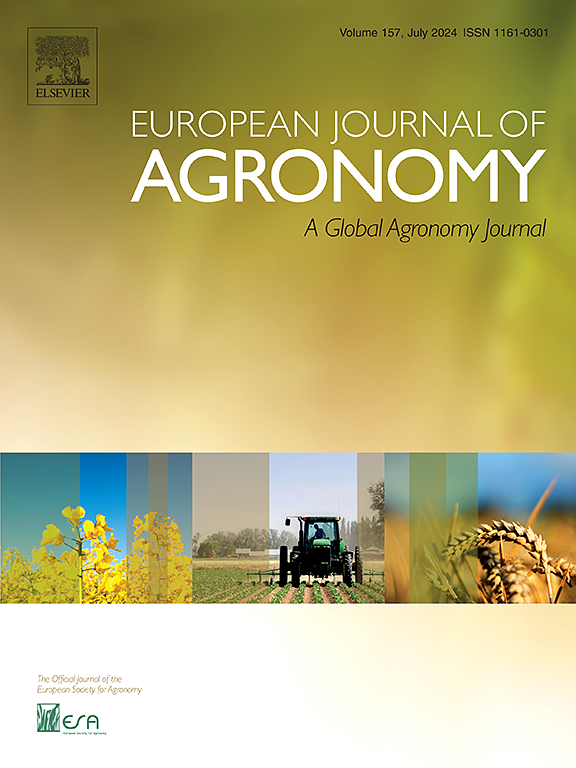Enhanced seed yield of full-season soybean when rotated with cereals and cover crops as compared to monoculture in a long-term experiment
IF 4.5
1区 农林科学
Q1 AGRONOMY
引用次数: 0
Abstract
Soybeans are of great importance to the global economy, but the cultivation as monoculture has shown several negative environmental implications in the long-term. Long-term studies demonstrate the cumulative effects of rotations on soil variables, but few studies have considered changes during consecutive years in a time series of soybean as a monoculture. The inclusion of cereals and cover crops in rotation with soybean increases the intensification sequence index (ISI, time with crops actively growing during the year) and increases in soybean yield are expected. In line with this, some studies suggest that only including a winter cover crop will increase ISI and raise production. However, these comparisons have not been made in the long term. The objectives of this work were to: i) compare the evolution of full-season soybean yield and production when sowed as monoculture and in cropping sequences that include cereal crops and cover crops, and ii) quantify a yield gap in full-season soybean due to monoculture by evaluating the long-term residual effect of crop sequences with different land occupation. Soybean yield time series in a 14-years period in rotation or as monoculture were studied in a long-term field experiment under no-tillage established in 2006 in the Northern Pampas region of Argentina. Rotations consisted in sequences that included soybean (S), maize (M) and wheat (W), and also incorporated wheat as a winter cover crop (CC): S-S, CC/S-CC/S, S-W/S-M, CC/S-W/S-M, M-W/S, and CC/M-W/S, with ISI values of 0.39, 0.69, 0.55, 0.64, 0.65 and 0.80, respectively. In 2021/22 season, full-season soybean was planted in all plots as a "test" crop, to evaluate the long-term residual effect of sequences with different intensification indexes. Seed yield averaged 3249 kg ha−1 among years. During the 14 years under study, seed yield in S-W/S-M surpassed S-S by 28 % in 6 out of 14 years. The differences between S-S with respect to this sequence were observed consistently from the ninth crop season (i.e. since 2017/18). The inclusion of a cover crop within a soybean monoculture (i.e. CC/S-CC/S) showed similar seed yields as in S-S in 11 out of 14 years. The analysis of the test crop showed yield-gaps when soybeans were grown as monoculture (seed yield in rotations minus seed yield in S-S) of 9, 20, 27, 21 and 31 % for CC/S-CC/S, S-W/S-M, CC/S-W/S-M, M-W/S and CC/M-W/S, respectively. In summary, soybean in rotation with cereals showed an average increase of ca. 346 kg ha−1 and including a cover crop within a soybean monoculture did not increase seed yield at the levels observed when rotated with cereals. Finally, when estimating seed yield-gaps in soybean, it is important to set in which rotation soybean is placed, since a higher maximum yield is expected to happen when soybean follows a more intensified rotation.
在一项长期试验中,与谷物和覆盖作物轮作的全季大豆种子产量高于单一种植的全季大豆种子产量
大豆对全球经济具有重要意义,但长期单一种植大豆会对环境造成一些负面影响。长期研究证明了轮作对土壤变量的累积效应,但很少有研究考虑大豆单一种植时间序列中连续几年的变化。将谷物和覆盖作物与大豆轮作,可提高强化序列指数(ISI,一年中作物积极生长的时间),从而提高大豆产量。与此相一致,一些研究表明,只种植冬季覆盖作物会增加 ISI 并提高产量。然而,这些比较并不是长期进行的。这项工作的目标是:i) 比较大豆单季播种与包括谷类作物和覆盖作物在内的种植序列下大豆全季产量和生产的变化;ii) 通过评估不同土地占用的作物序列的长期剩余效应,量化单季播种导致的大豆全季产量差距。2006 年,在阿根廷北潘帕斯地区进行了一项长期免耕田间试验,研究了 14 年间大豆轮作或单作的产量时间序列。轮作包括大豆 (S)、玉米 (M) 和小麦 (W) 的轮作序列,还包括作为冬季覆盖作物 (CC) 的小麦:S-S、CC/S-CC/S、S-W/S-M、CC/S-W/S-M、M-W/S 和 CC/M-W/S 的 ISI 值分别为 0.39、0.69、0.55、0.64、0.65 和 0.80。2021/22 年种植季,所有地块都种植了全季大豆作为 "测试 "作物,以评估不同强化指数序列的长期剩余效应。各年的平均种子产量为 3249 千克/公顷。在研究的 14 年中,S-W/S-M 的种子产量比 S-S 高出 28%。从第九个作物季开始(即自 2017/18 年起),S-S 之间在这一序列上的差异被持续观察到。在大豆单作中加入覆盖作物(即 CC/S-CC/S),14 年中有 11 年的种子产量与 S-S 相似。对试验作物的分析表明,在大豆单一种植时,CC/S-CC/S、S-W/S-M、CC/S-W/S-M、M-W/S 和 CC/M-W/S 的产量差距(轮作的种子产量减去 S-S 的种子产量)分别为 9%、20%、27%、21% 和 31%。总之,与谷物轮作的大豆平均每公顷增产约 346 千克,而在大豆单作中加入覆盖作物并不能提高种子产量,与与谷物轮作时的水平相当。最后,在估算大豆的种子产量差距时,必须确定大豆的轮作方式,因为如果大豆的轮作强度更大,预计最高产量也会更高。
本文章由计算机程序翻译,如有差异,请以英文原文为准。
求助全文
约1分钟内获得全文
求助全文
来源期刊

European Journal of Agronomy
农林科学-农艺学
CiteScore
8.30
自引率
7.70%
发文量
187
审稿时长
4.5 months
期刊介绍:
The European Journal of Agronomy, the official journal of the European Society for Agronomy, publishes original research papers reporting experimental and theoretical contributions to field-based agronomy and crop science. The journal will consider research at the field level for agricultural, horticultural and tree crops, that uses comprehensive and explanatory approaches. The EJA covers the following topics:
crop physiology
crop production and management including irrigation, fertilization and soil management
agroclimatology and modelling
plant-soil relationships
crop quality and post-harvest physiology
farming and cropping systems
agroecosystems and the environment
crop-weed interactions and management
organic farming
horticultural crops
papers from the European Society for Agronomy bi-annual meetings
In determining the suitability of submitted articles for publication, particular scrutiny is placed on the degree of novelty and significance of the research and the extent to which it adds to existing knowledge in agronomy.
 求助内容:
求助内容: 应助结果提醒方式:
应助结果提醒方式:


